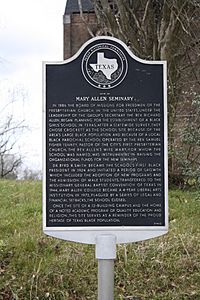Mary Allen Seminary facts for kids
Mary Allen Seminary was a very important school in Texas. It was the first college in the state specifically for Black women. The school was first started in 1886 by a church group called the Presbyterians.
Later, in 1924, the school changed. It became an official junior college. By 1933, all the teachers and leaders at the school were Black. The school closed in 1943 but opened again the next year. It continued to teach students until 1972.
History of Mary Allen Seminary
Starting as a Seminary
Mary Allen Seminary began in Crockett, Texas, in 1886. It was founded by a Presbyterian pastor named Reverend Richard Allen and his wife, Mary E. Allen. At that time, there were almost 200,000 Black women in Texas who had been freed from slavery. This school was the only one open to them.
The idea for the school started in 1885. Mary Allen played a big part in planning it. Crockett was chosen because many Black people lived there. Also, there was already a small church school for Black students in the area. In January 1886, the first three teachers arrived. They started teaching in a rented farmhouse. Mary Allen passed away in April 1887, and the school was named in her honor.
At first, the school taught a wide range of subjects, like history and science. This is called a liberal arts education. But some people thought the school should also teach skills for jobs. So, the school started teaching things like cooking, sewing, and even how to make hats (called millinery).
By the end of its first year, 46 students were enrolled. A brick building was built for students and teachers to live in. As more students joined, people in Crockett and other parts of the United States gave land and money to the school. By 1891, the campus had grown to 260 acres. Another brick building was added, named after a helper from Michigan, Senator James McMillan.
Even though all the students were Black, the first teachers at the seminary were white women. In 1921, a newspaper ad for the school looked for "white lady teachers." It offered 44 dollars a month for eight months, plus food and travel money.
Becoming a Junior College
In 1924, a Black leader named Reverend Burt Randall Smith was put in charge. His job was to reorganize Mary Allen Seminary. For the next eight years, Reverend Smith worked to improve the school. He made the library bigger and added more science equipment.
In 1932, the school became an official junior college. This meant it met high standards for education. All the teachers at the school were now Black. In 1933, the school changed its name to Mary Allen Junior College. It also started accepting both boys and girls, becoming a coeducational school.
The school closed in 1943. There was a plan to turn it into a state college for Black students, but it didn't happen. In 1944, a group called the National Missionary Baptist Convention of America reopened the school. It continued to operate and educate students until 1972.





